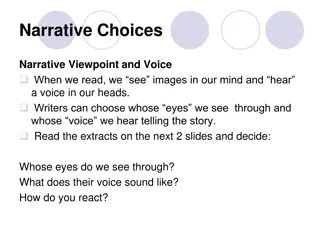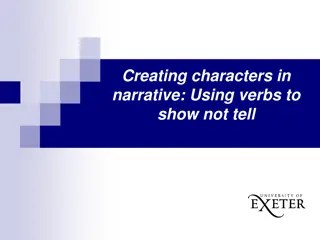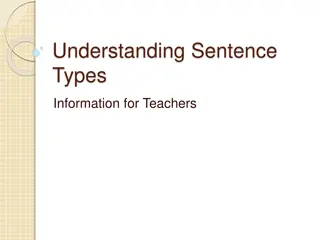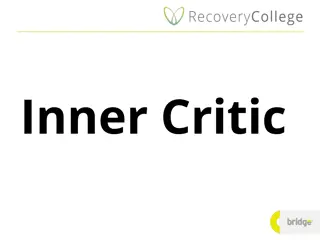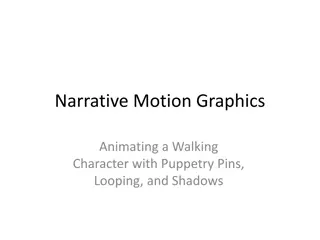
Crafting Compelling Characters Through Inner Reflections
Discover the art of creating characters in narratives through inner reflections. Explore techniques such as "show, not tell" and deep character development to engage readers on a profound level. Uncover the importance of detailing inner thoughts and feelings to breathe life into your characters.
Download Presentation

Please find below an Image/Link to download the presentation.
The content on the website is provided AS IS for your information and personal use only. It may not be sold, licensed, or shared on other websites without obtaining consent from the author. If you encounter any issues during the download, it is possible that the publisher has removed the file from their server.
You are allowed to download the files provided on this website for personal or commercial use, subject to the condition that they are used lawfully. All files are the property of their respective owners.
The content on the website is provided AS IS for your information and personal use only. It may not be sold, licensed, or shared on other websites without obtaining consent from the author.
E N D
Presentation Transcript
Creating characters in narrative through inner reflections
LEAD Principles PRINCIPLE LINKS EXPLANATION RATIONALE To establish a purposeful learning reason for addressing grammar, and connect grammar with meaning and rhetorical effect Make a link between the grammar being introduced and how it works in the writing being taught To avoid writing lessons becoming mini- grammar lessons, and to allow access to the structure even if the grammar concept is not fully understood To integrate reading and writing and show how real writers make language choices EXAMPLES Explain the grammar through examples, not lengthy explanations AUTHENTIC TEXTS Use authentic texts as models to link writers to the broader community of writers To promote deep metalinguistic learning about why a particular choice works, and to develop independence rather than compliance DISCUSSION Build in high-quality discussion about grammar and its effects
Creating Characters in Narrative Show not tell: reveal your character through showing what they are like, not just telling the reader; Use specific, concrete detail to describe characters to make your readers believe in them; Create strong visual descriptions which allow your reader to see the character in their own mind s eye; Think about how you name your characters; Reveal inner reflections so your readers know what your characters are thinking and feeling; Use dialogue to reveal your character.
Noticing Details in a Text They ve gone now and I m alone at last. I have the whole of the night ahead of me, and I won t waste a single moment of it. I shan t sleep it away. I won t dream it away either. I mustn t, because every moment of it will be far too precious. I want to try to remember everything, just as it was, just as it happened. I ve had nearly eighteen years of yesterdays and tomorrows, and tonight I must remember as many of them as I can. I want tonight to be long, as long as my life, not filled with fleeting dreams that rush me on towards dawn. Tonight, more than any other night of my life, I want to feel alive. Read the opening to Private Peaceful , a novel set in the First World War, where the main character, Tommo, narrates the story. What do we find out about Tommo? Look for: facts about him his thoughts and feelings Authentic text Discussion
Noticing Details in a Text Examples They ve gone now and I maloneat last. I have the whole of the night ahead of me, and I won t waste a single moment of it. Ishan t sleep it away. I won t dream it away either. I mustn t, because every moment of it will be far too precious. I want to try to remember everything, just as it was, just as it happened. I ve had nearly eighteen years of yesterdays and tomorrows, and tonight I must remember as many of them as I can. I want tonight to be long, as long as my life, not filled with fleeting dreams that rush me on towards dawn. Tonight, more than any other night of my life, I want to feel alive. Discussion What are the advantages of choosing a first-person narrator to tell the story? Are there any disadvantages?
Noticing Details in a Text Examples They ve gone now and I m alone at last. I have the whole of the night ahead of me, and I won t waste a single moment of it. I shan t sleep it away. I won t dream it away either. I mustn t, because every moment of it will be far too precious. I want to try to remember everything, just as it was, just as it happened. I ve had nearly eighteen years of yesterdays and tomorrows, and tonight I must remember as many of them as I can. I want tonight to be long, as long as my life, not filled with fleeting dreams that rush me on towards dawn. Tonight, more than any other night of my life, I want to feel alive. Discussion What are the advantages of narrating a story mostly in the present tense? Are there any disadvantages?
Noticing Details in a Text Examples They ve gone now and I m alone at last. I have the whole of the night ahead of me, and I won t waste a single moment of it. I shan t sleep it away. I won t dream it away either. I mustn t, because every moment of it will be far too precious. I want to try to remember everything, just as it was, just as it happened. I ve had nearly eighteen years of yesterdays and tomorrows, and tonight I must remember as many of them as I can. I want tonight to be long, as long as my life, not filled with fleeting dreams that rush me on towards dawn. Tonight, more than any other night of my life, I want to feel alive. Links Look at the number of thinking and reflecting verbs What do these verbs reveal about the character s inner thoughts and feelings?
Verbalising the Grammar-Writing Link A crucial element of the LEAD principles is helping writers to think explicitly (metalinguistically) about the choices they make. As a teacher, you need to support this by being crystal clear yourself about how you verbalise the link between a grammar choice and its effect in a particular text/context. Then express this in student-friendly language, as below. Verbalisation to share with students: When you are creating characters in narrative, you can show their inner reflections so your readers know what your characters are thinking and feeling. Think carefully about choices of first person voice, present tense and thinking/reflecting verbs.




